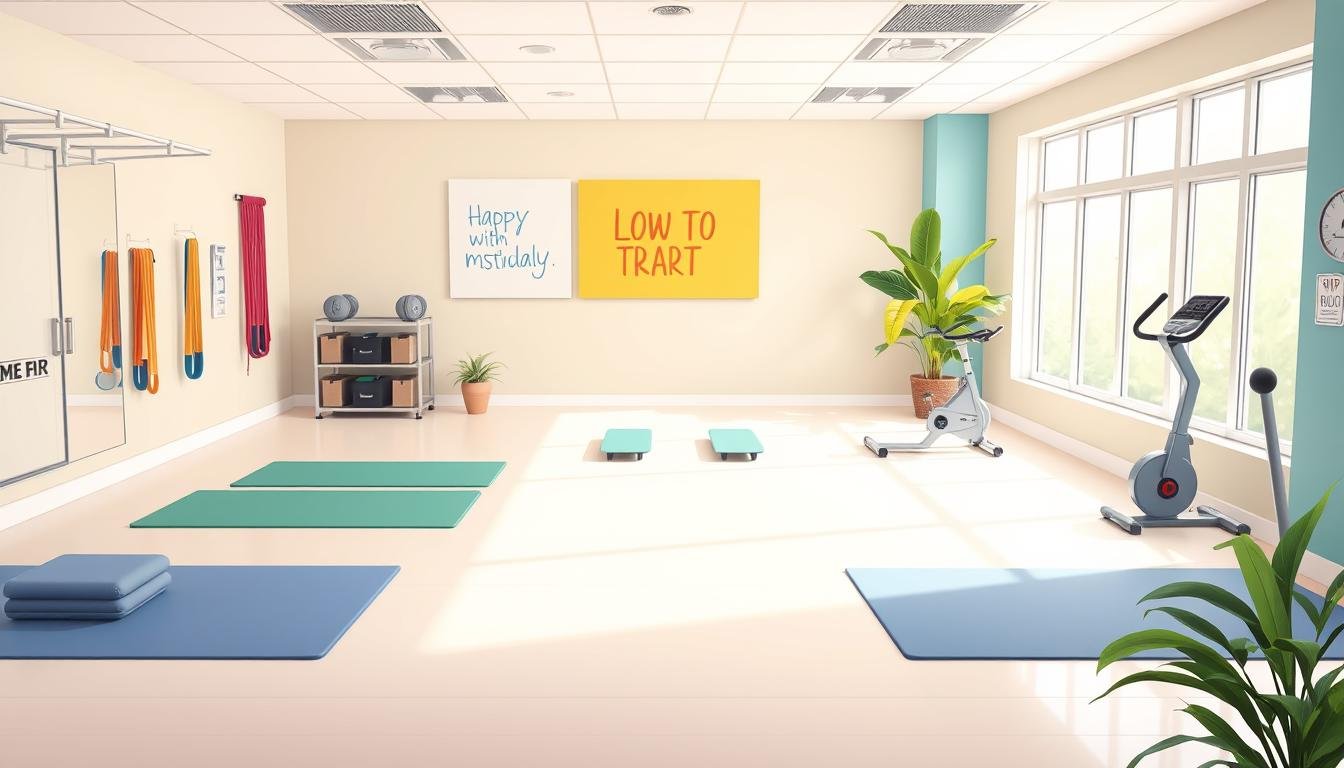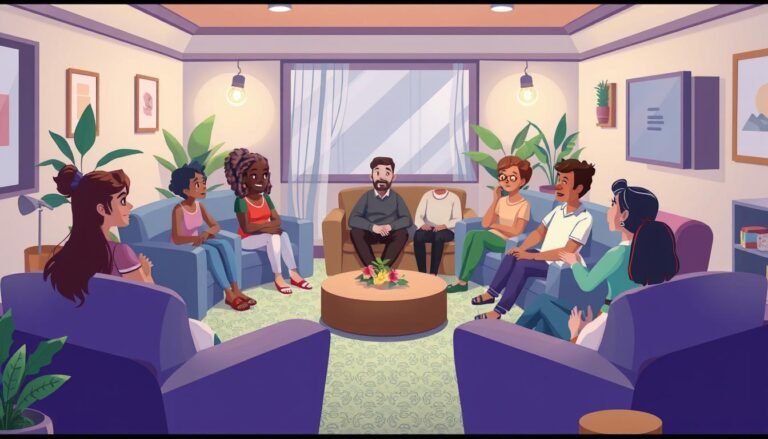Rehabilitation Therapy: Restoring Health & Function
Can one therapy change lives for all ages and abilities? Rehabilitation therapy does just that, bringing hope and healing to many. It has shown amazing results, like improving strength and balance by 30% in most patients.
It boosts memory by 25% in brain injury recovery and helps 80% of people get back to work after illness or injury. Rehabilitation therapy includes physical, occupational, and speech therapy. Each is designed to meet specific needs and goals.
If you’re recovering from surgery, managing chronic pain, or trying to get back to daily activities, rehabilitation therapy can help. It has helped 90% of patients with speech issues and 40% more independent at home and work. The results are clear.
Let’s dive into how rehabilitation therapy is changing healthcare. It’s making a big difference in the lives of people from all walks of life.
Understanding Rehabilitation Therapy
Rehabilitation therapy is key in helping people get better after injuries, illnesses, or disabilities. It aims to bring back health and better lives for millions globally.
Definition and Core Principles
Rehabilitation therapy includes many interventions to improve function and reduce disability. It works on physical, cognitive, and communication skills with tailored care plans. For example, cognitive rehabilitation helps with thinking and memory skills.
Types of Rehabilitation Services
There are many rehabilitation services for different needs:
- Physical therapy for mobility and strength
- Occupational therapy for daily living skills
- Speech therapy for communication disorders
- Stroke rehabilitation for recovery after cerebrovascular events
- Neurological rehabilitation for brain and nervous system conditions
The Role of Rehabilitation in Healthcare
Rehabilitation is vital in healthcare. It works alongside medical treatments to aid recovery and improve long-term health. For instance, stroke rehabilitation helps patients regain independence and return to daily activities.
“Rehabilitation is not just about recovery; it’s about empowering individuals to live their best lives despite health challenges.”
As the world ages and chronic conditions rise, the need for rehabilitation grows. Yet, many face barriers in accessing these services. This calls for more investment and awareness in this crucial healthcare area.
Benefits and Impact of Therapeutic Interventions
Therapeutic interventions greatly improve health and well-being. They help with injury and geriatric rehabilitation. These methods benefit people of all ages and health conditions.
Physical Health Improvements
Therapeutic exercise boosts physical health. It can improve aerobic capacity. This is done by using a formula that considers age, sex, and height.
Exercise also fights inflammation and keeps joints healthy. It does this by improving the flow of synovial fluid.
Enhanced Quality of Life
Rehabilitation therapy makes daily life easier and more independent. It’s especially helpful for older adults. It keeps them mobile and lowers the chance of falls.
It also helps manage chronic conditions like diabetes. This is because exercise improves how the body handles glucose and insulin.
Prevention of Secondary Conditions
Starting rehabilitation early can stop other health problems. It helps avoid chronic pain and mobility issues. Exercise is also good for people with osteoarthritis, offering benefits for 2 to 6 months.
Cost-Effectiveness and Long-term Outcomes
Therapeutic interventions save money. They often mean fewer hospital stays and readmissions. This leads to big savings in healthcare costs.
They also improve long-term function and social participation. People can work and socialize more easily.
| Therapeutic Exercise Type | Benefits | Application |
|---|---|---|
| Endurance Training | Improves cardiovascular health | Cardiopulmonary disorders |
| Resistance Training | Increases strength and muscle mass | Musculoskeletal disorders |
| Flexibility Training | Enhances range of motion | Joint stiffness, injury prevention |
Professional Rehabilitation Therapy Services
Rehabilitation therapy services are provided by a team of skilled healthcare professionals. Physical therapists, occupational therapists, and speech therapists are at the heart of this team. They work in places like hospitals, clinics, and homes.
At Rancho Los Amigos National Rehabilitation Center, the care quality is clear:
- Over 90 years of clinical expertise in rehabilitation
- More than half of their physical therapists hold a clinical Doctor of Physical Therapy degree
- Over 25% are Board-Certified Specialists in Neurologic, Geriatric, or Orthopedic Physical Therapy
The Department of Veterans Affairs (VA) shows the size of these services:
| Category | Number |
|---|---|
| Physical Therapists employed | 3,100+ |
| Physical Therapy Assistants employed | 670+ |
| Unique patients treated (2023) | 829,000+ |
| Total patient encounters (2023) | 3.88 million |
Professional rehabilitation services include detailed assessments and personalized plans. Physical, occupational, and speech therapists work together. They adjust plans as needed to help patients reach their best.
Rehabilitation is not just about recovery; it’s about empowering individuals to reach their full potential.
The commitment to top-notch rehabilitation therapy is clear. Rancho Los Amigos offers about 35 internships a year. The VA has the biggest Physical Therapy residency program, with 83 residents graduating soon.
Treatment Approaches and Techniques
Rehabilitation therapy offers many ways to help patients get better and live better lives. These methods tackle different physical issues and aim for overall health.
Manual Therapy and Hands-on Treatment
Manual therapy is key in rehab. It includes moving joints, massaging, and stretching to lessen pain and boost movement. Therapists use methods like Swedish massage, deep tissue massage, and sports massage to focus on specific areas.
Therapeutic Exercise Programs
Therapeutic exercise is a big part of many rehab plans. These programs aim to strengthen muscles, improve flexibility, and boost physical function. Exercises might include:
- Weight training to fight osteoporosis
- Aerobic activities like walking and cycling
- Stabilization and balance exercises for joint health
- Aquatic therapy for those with joint pain or arthritis
Assistive Devices and Technology
Assistive devices are crucial in rehab. They include prosthetics, orthotics, and mobility aids that help with independence and safety. Some common therapy tools include:
- TENS units for pain relief
- NMES for learning muscle function
- Ultrasound for treating sprains and tendonitis
- Iontophoresis for delivering medication
Environmental Modifications
Changing living spaces is important for patient safety and independence. Therapists check out home environments and suggest changes to make them more accessible and safe. This might mean installing grab bars, rearranging furniture, or changing bathroom fixtures.
By mixing these different methods, rehab experts create plans that meet each patient’s unique needs and goals.
Conclusion
Rehabilitation therapy is key in helping people get back to their lives. It has shown great results, like improving mobility for stroke survivors. Even if some treatments don’t directly improve quality of life, they help people do more in their daily lives.
At the core of rehabilitation is patient-centered care. The numbers are striking – nearly 0.8 million strokes happen in the U.S. each year. Also, up to 400,000 service members suffer brain injuries. This highlights the need for effective treatments.
Looking to the future, rehabilitation therapy is getting better. New tools like robotic-assisted movement and virtual reality training are promising. But, there are still hurdles to overcome, like making treatments standard and proving they work on a big scale. As research goes on, the focus on patient care and better outcomes will guide the field forward.
Source Links
- 7 Types of Rehabilitation Therapy
- The Role of Physical Therapy in Rehabilitation: Restoring Mobility and Independence – H2 Health
- Rehabilitation
- Rehabilitation: MedlinePlus
- Difference Between Rehabilitation and Physical Therapy
- Therapeutic Exercise – StatPearls – NCBI Bookshelf
- Why Early Intervention Is Important In Mental Health and Substance Use Disorder Treatment | Rise Above Treatment
- Physical Therapy – Rancho Los Amigos National Rehabilitation Center
- VA.gov | Veterans Affairs
- Physical Therapy – Rancho Los Amigos National Rehabilitation Center
- 12 Common Ways Physical Therapists Treat Injuries
- The Different Types of Physical Therapy Treatments
- Conclusions – Rehabilitation aimed at improving outdoor mobility for people after stroke: a multicentre randomised controlled study (the Getting out of the House Study)
- Frontiers | Adopting Text Mining on Rehabilitation Therapy Repositioning for Stroke
- Brain Specialists Reach Unanimous Conclusion








